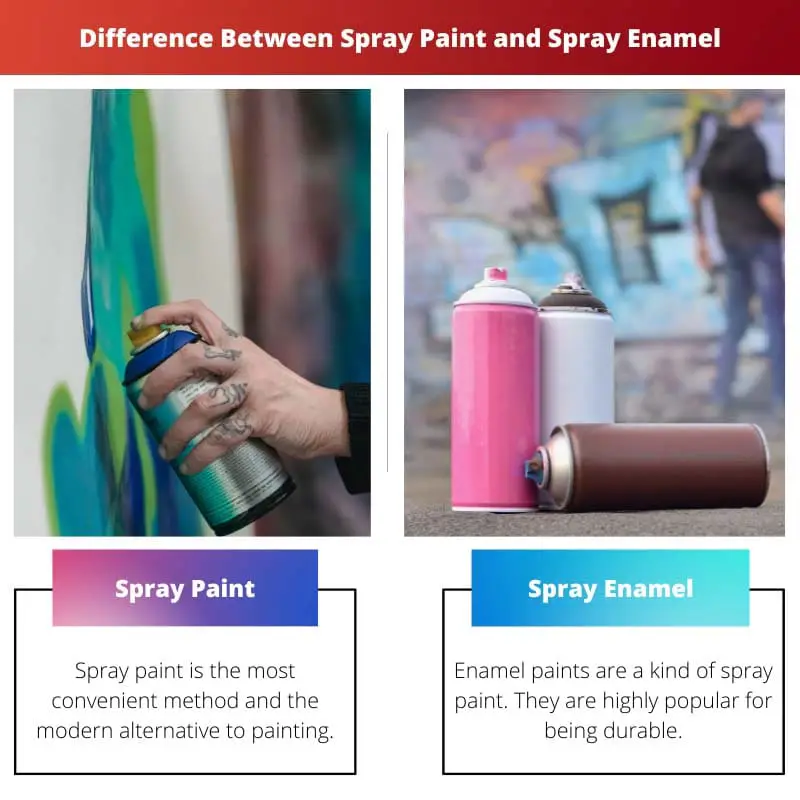Paint is a liquid substance via which one can portray their skill. However, the more practical reasoning for paint is it is used to protect surfaces from several problems such as rust, heat, water, and other environmental elements.
A modern alternative way of applying paint is seen these days is spray paint. It is a more effective and efficient way of applying paint on surfaces.
Key Takeaways
- Spray paint is an aerosol-based paint that dries quickly and offers easy application, while spray enamel is a type of paint with a glossy, durable finish that protects against wear and weather.
- Spray enamel is more resistant to chipping, fading, and corrosion than spray paint, making it suitable for long-lasting applications on various surfaces.
- Spray paint is available in a broader range of colors and finishes, while spray enamel has a limited selection of glossy colors.
Spray Paint vs Spray Enamel
Spray paint is a type of paint that is sprayed onto a surface using an aerosol can. It is used to add color and a protective finish to a surface. Spray enamel is a type of paint designed to be more durable, lustre, long-lasting, and resistant to scratches, moisture, chips, and fading.

Spray paint is the most convenient method and the modern alternative to painting. The liquid paint is stored in aerosol cans and dispersed using a nozzle on top of the dispenser.
Spray paints are further classified on the type of paints they are. It is a very broad classification. With paints to cater to everyone’s needs.
Enamel paints are a kind of spray paint. They are highly popular for being durable. They have a glossy finish.
They also dry up very quickly. Spray enamels are used for painting outdoor furniture to withstand harsh climatic changes.
Comparison Table
| Parameter of Comparison | Spray Paint | Spray Enamel |
|---|---|---|
| Specification | It is a general term | It is a specific term |
| Classification | It has several broad layers of classification | Does not have any sort of classification |
| Stain | It depends upon the paint that is chosen | Stain-resistant |
| Finish | Depends upon the paint that is chosen | Glossy finish |
| Protection | It depends upon the pain that is chosen | Long-lasting |
What is Spray Paint?
Liquid paint stored in aerosol cans with a mechanism of spray on top of the dispenser for small DIY projects or industrial purposes is known as spray paints.
It is one of the most popular approaches to painting apart from using the old-school paintbrush. Spray paints are less messy to work with and do not require much expertise to function.
Several different kinds of spray paints are available depending upon the base they are made up of or the finish they provide.
Depending upon the finish spry pains can be classified as flat (matte), glossy, semi-glossy, high-gloss, satin, and metallic.
Apart from that spray paints can also be classified based on their texture or other specific features, they are- general purpose paint, lacquer, epoxy, high-heat, chalkboard, frosted, enamel, acrylic, oil-based, and rust preventive.
Before one chooses a specific kind of spray certain factors should be kept under notice such as the surface that is being painted, as some surfaces may require sanding and a layer of primer before spraying while others do not they can be painted upon directly.

What is Spray Enamel?
Spray enamel is a kind of spray paint, identified based on its texture. In the easiest since it is a kind of paint that is solvent-based and it dries up to be quite hard like a glass shell.
Enamel paint layers are given as a protective layer.
Enamel leaves a glossy finish. Enamel is popularly used by artisans to provide evocative colors and permanence to their crafts.
However, for industrial purposes, enamel paints are used to cover appliances like refrigerators and washing machines.
Spray enamel provides a uniform finish. It looks very professional. Enamel paints are resistant to yellowing as they have a very good protective nature.
The application procedure for spray enamel is quite smooth as does not require prior training or expertise. Spray enamel as a substance can be applied to a wide range of surfaces.
While the process of spaying enamel can be a very easy task, however during the process strong odor is released from the enamel therefore protective gears must be worn at all times while working with spray enamels.
Another drawback of spray enamel can be that they are quite expensive.
Main Differences Between Spray Paint and Spray Enamel
- Spray paint is not a specific term. It can mean several different kinds of spray paint however, spray enamel is a very specific term and it means a specific product.
- Spray paint can be classified into several types under the basis of its purposes such as lacquer, acrylic, frosted, enamel, and many more. Spray enamel however cannot be further classified as it is a classification itself.
- Spray paint is a very broad classification that does not have one particular stain it depends upon the paint. Spray enamel, however, is stain-resistant; therefore it is used in furniture to make cleaning easy.
- Spray paint can be matte, semi-gloss, gloss, high-gloss, satin and of metallic finish depending upon the pain that is chosen. Spray enamel, however, on using provides a glossy finish along with a variety of colors.
- Spray paint, being a broad classification the nature of the paint depends on the paint that is being used. Spray enamel, however, is very long-lasting and durable. It acts as a protective layer between the surface painted and the atmosphere.

- https://www.jstor.org/stable/4177680
- https://www.sciencedirect.com/science/article/pii/S0360544204000489
